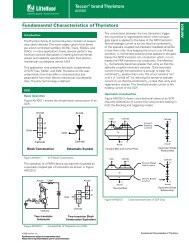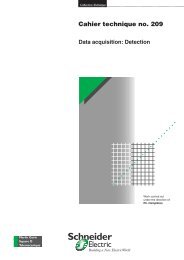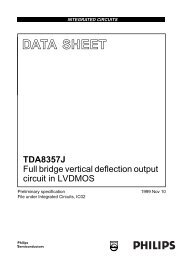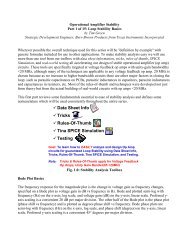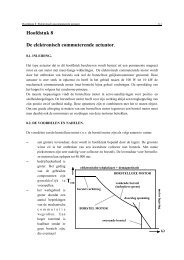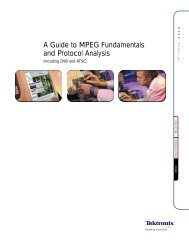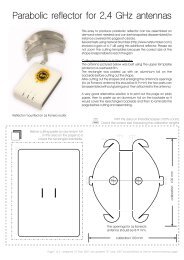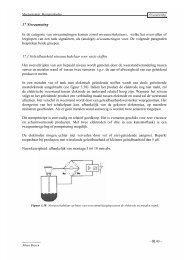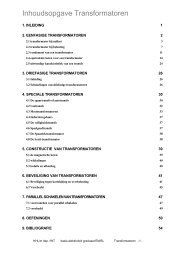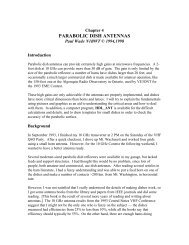Temperature Sensing with a Programmable Gain Amplifier - Microchip
Temperature Sensing with a Programmable Gain Amplifier - Microchip
Temperature Sensing with a Programmable Gain Amplifier - Microchip
You also want an ePaper? Increase the reach of your titles
YUMPU automatically turns print PDFs into web optimized ePapers that Google loves.
M AN867<br />
<strong>Temperature</strong> <strong>Sensing</strong> With A <strong>Programmable</strong> <strong>Gain</strong> <strong>Amplifier</strong><br />
Author: Bonnie C. Baker<br />
<strong>Microchip</strong> Technology Inc.<br />
INTRODUCTION<br />
Although it is simple to measure temperature in a<br />
stand-alone system <strong>with</strong>out the help of <strong>Microchip</strong>’s <strong>Programmable</strong><br />
<strong>Gain</strong> <strong>Amplifier</strong>s (PGA), a variety of problems<br />
can be eliminated by implementing temperaturesensing<br />
capability in multiplexed applications <strong>with</strong> a<br />
PGA. One of the main advantages is that you can eliminate<br />
a second signal path to the microcontroller and<br />
still maintain the accuracy of your sensing system. In<br />
particular, the multiplexed PGAs you can use are the<br />
MCP6S22 (two-channel), MCP6S26 (six-channel), and<br />
MCP6S28 (eight-channel).<br />
The most common sensors for temperature measurements<br />
are the Thermistor, Silicon <strong>Temperature</strong> Sensor,<br />
RTD and Thermocouple. <strong>Microchip</strong>’s PGAs are best<br />
suited to interface to the Thermistor or Silicon<br />
<strong>Temperature</strong> Sensor.<br />
In this application note we will discuss the implementation<br />
of temperature measurement systems from sensor<br />
to the PICmicro ® microcontroller using a NTC Thermistor,<br />
Silicon <strong>Temperature</strong> sensor, PGA, anti-aliasing<br />
filter, A/D converter and microcontroller.<br />
INTERFACING THE PGA TO<br />
THERMISTORS<br />
The most appropriate configuration when using a NTC<br />
thermistor <strong>with</strong> <strong>Microchip</strong>’s PGA is in the resistanceversus-temperature<br />
mode. The resistance of an NTC<br />
thermistor has a negative, non-linear temperature coefficient<br />
response. The resistance-versus-temperature<br />
response of a 10 kΩ, NTC thermistor is shown in<br />
Figure 1.<br />
10000000<br />
1000000<br />
100<br />
-100 -50 0 50 100 150<br />
<strong>Temperature</strong> (°C)<br />
FIGURE 1: The NTC thermistor has a<br />
non-linear resistance response over temperature<br />
<strong>with</strong> a negative temperature coefficient.<br />
It is obvious in this example that this type of response<br />
is inefficient in a linear system. Typically, analog integrated<br />
circuits are linear in nature, as are <strong>Microchip</strong>’s<br />
PGA devices. A first-level linearization of the thermistor<br />
output can be implemented <strong>with</strong> the circuits in Figure 2.<br />
This type of circuit will perform precision temperature<br />
measurement over, approximately, a 50°C temperature<br />
range. In this figure, the thermistor is placed in series<br />
<strong>with</strong> a standard resistor (R SER, 1%, metal film) and a<br />
voltage source.<br />
FIGURE 2: The NTC thermistor can be<br />
linearized over a 50°C range <strong>with</strong> a voltage<br />
source and series resistance. Figure 2A has a<br />
positive temperature coefficient, while Figure 2B<br />
has a negative temperature coefficient at V THER.<br />
© 2003 <strong>Microchip</strong> Technology Inc. DS00867A-page 1<br />
NTC Thermistor Resistance (Ω)<br />
100000<br />
10000<br />
1000<br />
V DD or V SEN *<br />
NTC<br />
Thermistor<br />
A. VTHER B.<br />
R SER<br />
(±1% tolerance,<br />
metal film)<br />
10 kΩ @ 25ºC thermistor<br />
V DD or V SEN *<br />
RSER (±1% tolerance,<br />
metal film)<br />
VTHER NTC<br />
Thermistor<br />
* V SEN is a precision voltage reference
AN867<br />
The value of R SER is equal to the value of the thermistor<br />
at the median temperature of the 50°C window<br />
you are trying to measure. For instance, if a 10 kΩ NTC<br />
thermistor is selected, this specification implies that the<br />
thermistor will be 10 kΩ at 25°C. If the measurement<br />
window is between 0°C and 50°C, the standard resistor<br />
(R SER) should be 10 kΩ. The response of V THER in<br />
Figure 2, Diagram A is shown in Figure 3.<br />
V OUT (V)<br />
Voltage Out <strong>with</strong> 10 kΩ NTC Thermistor<br />
in Series <strong>with</strong> 10 kΩ 1% Resistor and 5V Excitation<br />
(Omega, 44006 Thermistor, 10 kΩ @ 25°C)<br />
5.0<br />
2.5<br />
2.0<br />
4.0<br />
1.5<br />
3.0<br />
2.0<br />
VOUT Error<br />
1.0<br />
0.5<br />
0.0<br />
-0.5<br />
-1.0<br />
1.0<br />
-1.5<br />
-2.0<br />
0.0<br />
-2.5<br />
-50 -25 0 25 50 75 100<br />
<strong>Temperature</strong> (°C)<br />
Error (°C)<br />
FIGURE 3: The NTC thermistor has a<br />
non-linear resistance response over temperature.<br />
0.1 uF<br />
V DD<br />
NTC Thermistor<br />
44006 (Omega)<br />
VTHER RSER 10 kΩ<br />
2 CH0<br />
3 CH1<br />
4 CH2<br />
5 CH3<br />
6 CH4<br />
7 CH5<br />
MUX<br />
0.1 uF<br />
V DD<br />
VDD 0.1 uF<br />
VREF MCP6S26<br />
A<br />
MCP41100<br />
8,5<br />
W 6 3<br />
+<br />
VDD 0.1 uF<br />
8<br />
8 9<br />
B<br />
4,7 1 3 2<br />
1<br />
MCP6022<br />
2<br />
0.1 uF –<br />
4<br />
14<br />
+<br />
Internal<br />
PGA<br />
–<br />
1<br />
13<br />
11<br />
10<br />
A circuit that shows the interface between thermistor<br />
and one of <strong>Microchip</strong>’s PGAs is shown in Figure 4. In<br />
this circuit, the output of the thermistor circuit (VTHER) is connected directly to one input of the PGA.<br />
The configuration for the thermistor circuit in this figure<br />
has a positive temperature coefficient. When a look-up<br />
table is utilized in the controller, this particular circuit is<br />
designed to test temperature from 0°C to 50°C <strong>with</strong> 10bit<br />
linear performance. The voltage at CH0 of the PGA<br />
is centered around 2.5V. The voltage swing of the thermistor<br />
circuits is from 1.5V (of 0°C sensing) to 4.0V (for<br />
50°C sensing). In this configuration, the PGA gain<br />
should be 1V/V and the reference voltage (VREF) should be 0V or ground.<br />
4.15 kΩ 16.3 kΩ<br />
2.2 nF<br />
6<br />
6.8 nF<br />
1 8<br />
5<br />
2<br />
6<br />
MCP3201<br />
7<br />
3<br />
4<br />
CS_ADC<br />
SDI<br />
SCK<br />
SDO<br />
CS_PGA<br />
CS_POT<br />
FIGURE 4: The linearized thermistor is connected directly to the MCP6S26, a six channel PGA.<br />
DS00867A-page 2 © 2003 <strong>Microchip</strong> Technology Inc.<br />
5<br />
+<br />
MCP6022<br />
–<br />
7<br />
VDD VDD<br />
0.1 uF 0.1 uF<br />
PIC16C63
INTERFACING THE PGA TO A<br />
SILICON TEMPERATURE SENSOR<br />
The Silicon <strong>Temperature</strong> Sensor is an alternative that<br />
can be interfaced <strong>with</strong> <strong>Microchip</strong>’s PGAs. Silicon <strong>Temperature</strong><br />
Sensors are available <strong>with</strong> various output<br />
structures, such as voltage out, digital out or logic out<br />
(which indicate temperature thresholds). <strong>Microchip</strong>’s<br />
voltage output Silicon <strong>Temperature</strong> sensors are used<br />
when driving the input of a multiplexed PGA. The voltage<br />
out Silicon <strong>Temperature</strong> Sensors from <strong>Microchip</strong><br />
are the TC1046, TC1047 and TC1047A.<br />
0.1 uF<br />
V DD<br />
1<br />
TC1047A 2<br />
3<br />
V DD<br />
AN867<br />
Although all of these sensors can be interfaced <strong>with</strong> the<br />
MCP6S26, the TC1047A is used in the example<br />
shown in Figure 5. The output range of the TC1047A,<br />
and, consequently, the programming of V REF and gain<br />
of the MCP6S26, is dependent on your measurement<br />
needs. Table 1 gives some example temperature<br />
ranges. Refer to the TC1047A data sheet (DS21498)<br />
for more information concerning your temperature<br />
measurement requirements.<br />
FIGURE 5: TC1047A Silicon <strong>Temperature</strong> Sensor from <strong>Microchip</strong> is interfaced <strong>with</strong> the 6-channel<br />
MCP6S26 PGA. The voltage reference on pin 8 of the MCP6S26 should be equal to 0V or ground. If a<br />
higher, smaller range of the output of the temperature sensor is targeted, the reference circuitry using the<br />
MCP41100 and MCP6022 could be used.<br />
TABLE 1: GIVEN A TEMPERATURE MEASUREMENT RANGE, THE KNOWN OUTPUT OF THE<br />
TC1047A IS USED IN THE CALCULATION TO OPTIMIZE THE MCP6S26 PGA.<br />
<strong>Temperature</strong><br />
Measurement<br />
Range (°C, typ)<br />
2 CH0<br />
3 CH1<br />
4 CH2<br />
5 CH3<br />
6 CH4<br />
7 CH5<br />
MUX<br />
0.1 uF<br />
0.1 uF<br />
MCP41100<br />
8,5<br />
A<br />
W 6 3<br />
+<br />
V<br />
MCP6S26<br />
REF<br />
V<br />
8 9<br />
DD<br />
0.1 uF<br />
8<br />
B<br />
4,7<br />
1<br />
MCP6022<br />
1 3 2 2<br />
0.1 uF –<br />
4<br />
TC1047A Minimum<br />
Output (V, typ)<br />
V DD<br />
14<br />
+<br />
Internal<br />
PGA<br />
–<br />
4.15 kΩ 16.3 kΩ<br />
1<br />
13<br />
11<br />
10<br />
2.2 nF<br />
6<br />
TC1047A Maximum<br />
Output (V, typ)<br />
6.8 nF<br />
1 8<br />
5<br />
7 2<br />
6<br />
MCP3201<br />
7<br />
3<br />
4<br />
PGA <strong>Gain</strong> (V/V) PGA V REF (V)<br />
-30 to +125 0.2 1.75 2 0<br />
-30 to +85 0.2 1.35 2 0<br />
0 to +70 0.5 1.2 5 0.5<br />
70 to +100 1.2 1.5 10 1.25<br />
CS_ADC<br />
SDI<br />
SCK<br />
SDO<br />
CS_PGA<br />
CS_POT<br />
© 2003 <strong>Microchip</strong> Technology Inc. DS00867A-page 3<br />
5<br />
+<br />
MCP6022<br />
–<br />
V DD VDD<br />
0.1 uF 0.1 uF<br />
PIC16C63
AN867<br />
Selection of PGA <strong>Gain</strong><br />
The maximum gain is easily calculated. Take the magnitude<br />
of the difference of the input and multiply by the<br />
various PGA gain options (1, 2, 4, 5, 8, 10 or 32).<br />
Choose the largest output while still being less than<br />
V DD - 600 mV (so that the PGA output remains in its<br />
linear region).<br />
PGA Reference Voltage<br />
The input range of the reference voltage pin is VSS to<br />
VDD of the PGA. In the circuit of Figure 5, VSS = Ground<br />
and VDD = 5V. The transfer function of the PGA is equal<br />
to:<br />
EQUATION<br />
V OUT<br />
= GV<br />
IN<br />
– ( G – 1)V<br />
REF<br />
With this ideal formula, the actual restrictions of the output<br />
of the PGA should be taken into consideration.<br />
Generally speaking, the output swing of the PGA is less<br />
that 25 mV from the rail, as specified in the MCP6S2X<br />
PGA data sheet (DS21117). However, to obtain good<br />
linear performance, the output should be kept <strong>with</strong>in<br />
300 mV from the supply rails. This is specified in the<br />
conditions of the “DC gain error” and “DC output nonlinearity”.<br />
Consequently, beyond the absolute voltage limitations<br />
on the PGA voltage reference pin, the voltage output<br />
swing capability further limits the selection of the voltage<br />
at pin 8. The formulas that can be used to calculate<br />
these values are:<br />
EQUATION<br />
V<br />
IN<br />
( min)<br />
≥ ( V<br />
OUT<br />
( min)<br />
+ ( G – 1)V<br />
REF<br />
) ⁄ G<br />
V<br />
IN<br />
( max)<br />
≤ ( V<br />
OUT<br />
( max)<br />
+ ( G – 1)V<br />
REF<br />
) ⁄ G<br />
where:<br />
VIN = input voltage to the PGA.<br />
VOUT(min) = minimum output voltage of PGA<br />
= VSS + 0.3V.<br />
VOUT(max) = maximum output voltage of PGA<br />
= VDD - 0.3V.<br />
G = gain of the PGA.<br />
VREF = Voltage applied to the PGA’s VREF pin.<br />
It should be noted that the voltage reference to the<br />
PGA can be set using a voltage reference device. A<br />
variable voltage reference may be required because of<br />
the various requirements on other channels of the<br />
PGA. If a variable voltage reference is required, the circuit<br />
in Figure 4 and Figure 5 can be used.<br />
DIGITIZING THE SIGNAL FOR THE<br />
MICROCONTROLLER<br />
In Figure 4 and Figure 5, the signal path takes the temperature<br />
voltage from the output of the PGA, through<br />
an anti-aliasing filter, into an A/D converter and then to<br />
the PICmicro ® microcontroller for further processing.<br />
At the output of the PGA, an anti-aliasing filter is<br />
inserted. This is done prior to the A/D conversion in<br />
order to reduce noise. The anti-aliasing filter can be<br />
designed <strong>with</strong> a gain of one or higher, depending on the<br />
circuit requirements. Again, the MCP6022 operational<br />
amplifier is used to match the frequency response of<br />
the PGA. <strong>Microchip</strong>’s FilterLAB ® software can be used<br />
to easily design this filter’s frequency cut-off and gain.<br />
The anti-aliasing filter in this circuit is a Sallen-Key<br />
(non-inverting configuration) <strong>with</strong> a cut-off frequency of<br />
10 Hz. This frequency is low enough to remove most of<br />
the noise in this, essentially, DC measurement.<br />
Generally speaking, the corner frequency should be<br />
selected to pass all of the input signals to the multiplexer<br />
in your specific design. For more information<br />
concerning the design of anti-aliasing filters, refer to<br />
<strong>Microchip</strong> Technology’s AN699, “Anti-Aliasing, Analog<br />
Filters for Data Acquisition Systems” (DS00699).<br />
Finally, the signal at the output of the filter is connected<br />
to the input of a 12-bit A/D converter (MCP3201). In<br />
this circuit, if noise is kept under control, it is possible<br />
to obtain 12-bit accuracy from the converter. Noise is<br />
kept under control by using an anti-aliasing filter (as<br />
shown in Figure 4 and Figure 5), appropriate bypass<br />
capacitors, short traces, linear supplies and a solid<br />
ground plane. The entire system is manipulated on the<br />
same SPI bus for the PGA, digital potentiometer and<br />
A/D converter <strong>with</strong> no digital feed through from the<br />
converter during conversion.<br />
DS00867A-page 4 © 2003 <strong>Microchip</strong> Technology Inc.
PERFORMANCE DATA<br />
This data was taken using one MCP6S26 and one<br />
Omega Thermistor (44006) and one TC1047A temperature<br />
sensor from <strong>Microchip</strong>. V DD was equal to 5V<br />
and V SS equal to ground. The data is reported reliably,<br />
but does not represent a statistical sample of the<br />
performance of all devices in the product family.<br />
Thermistor Response<br />
The 44006 thermistor from Omega is a 10 kΩ @ 25°C<br />
device <strong>with</strong> 0.2°C resistance tolerance at room temperature.<br />
The series resistor (RSER ) was 10 kΩ, making<br />
this temperature-sensing network linear ±1°C over a<br />
50°C range; 0°C to 50°C. Using 5V for VDD, the linear<br />
range of this network over-temperature is 1.17V (0°C)<br />
to 3.7V (50°C).The reference voltage applied to the<br />
MCP6S26 was ground, <strong>with</strong> the PGA gain set to 1. The<br />
reference voltage applied to the 12-bit A/D converter<br />
(MCP3201) was 5V and the 2nd order anti-aliasing filter<br />
frequency was 10 Hz.<br />
The data taken from this configuration is in Table 2.<br />
TABLE 2: FROM THE CIRCUIT DIAGRAM<br />
OF FIGURE 4, THE RESULTS OF TESTING<br />
WITH THE 10 kΩ @ 25°C, 44006 THERMISTOR<br />
FROM OMEGA.<br />
Temp.<br />
(°C)<br />
Output<br />
Voltage<br />
MCP6S26<br />
PGA<br />
Digital<br />
Output<br />
MCP3201<br />
12-bit<br />
Converter<br />
Expected<br />
PGA<br />
Output<br />
0 1.20 984 1.17<br />
5 1.45 1189 1.41<br />
10 1.68 1377 1.67<br />
15 1.96 1607 1.94<br />
20 2.22 1820 2.22<br />
25 2.49 2041 2.5<br />
30 2.77 2270 2.77<br />
35 3.03 2484 3.02<br />
40 3.27 2680 3.26<br />
45 3.47 2844 3.48<br />
50 3.66 3000 3.68<br />
CONCLUSION<br />
AN867<br />
The MCP6S2X family of PGAs have one-channel, twochannel,<br />
six and eight-channel devices in the product<br />
offering. Changing from channel-to-channel may entail<br />
a gain and reference voltage change. This could<br />
require three 16-bit communications to occur between<br />
the PGA and digital potentiometer. With a clock rate of<br />
10 MHz on the SPI interface, this would require<br />
approximately 3.4 µs. Additionally, the PGA amplifier<br />
would need to settle. Refer to the MCP6S2X PGA data<br />
sheet (DS21117) for the settling-time versus gain<br />
specification.<br />
This precision PGA device from <strong>Microchip</strong> not only<br />
offers excellent offset voltage performance, but the<br />
configurations in these temperature-sensing circuits<br />
are easily designed <strong>with</strong>out the headaches of stability<br />
that the stand-alone amplifier circuits present to the<br />
designer. Stability <strong>with</strong> these programmable gain<br />
amplifiers have been built-in by <strong>Microchip</strong> engineers.<br />
REFERENCES<br />
AN865, “<strong>Sensing</strong> Light <strong>with</strong> a <strong>Programmable</strong> <strong>Gain</strong><br />
<strong>Amplifier</strong>”, Bonnie C. Baker, <strong>Microchip</strong> Technology Inc.<br />
AN251, “Bridge <strong>Sensing</strong> <strong>with</strong> the MCP6S2X PGAs”,<br />
Bonnie C. Baker, <strong>Microchip</strong> Technology Inc.<br />
AN699, “Anti-Aliasing, Analog Filters for Data<br />
Acquisition Systems”, Bonnie C. Baker, <strong>Microchip</strong><br />
Technology Inc.<br />
© 2003 <strong>Microchip</strong> Technology Inc. DS00867A-page 5
AN867<br />
NOTES:<br />
DS00867A-page 6 © 2003 <strong>Microchip</strong> Technology Inc.
Note the following details of the code protection feature on <strong>Microchip</strong> devices:<br />
• <strong>Microchip</strong> products meet the specification contained in their particular <strong>Microchip</strong> Data Sheet.<br />
• <strong>Microchip</strong> believes that its family of products is one of the most secure families of its kind on the market today, when used in the<br />
intended manner and under normal conditions.<br />
• There are dishonest and possibly illegal methods used to breach the code protection feature. All of these methods, to our<br />
knowledge, require using the <strong>Microchip</strong> products in a manner outside the operating specifications contained in <strong>Microchip</strong>'s Data<br />
Sheets. Most likely, the person doing so is engaged in theft of intellectual property.<br />
• <strong>Microchip</strong> is willing to work <strong>with</strong> the customer who is concerned about the integrity of their code.<br />
• Neither <strong>Microchip</strong> nor any other semiconductor manufacturer can guarantee the security of their code. Code protection does not<br />
mean that we are guaranteeing the product as “unbreakable.”<br />
Code protection is constantly evolving. We at <strong>Microchip</strong> are committed to continuously improving the code protection features of our<br />
products. Attempts to break microchip’s code protection feature may be a violation of the Digital Millennium Copyright Act. If such acts<br />
allow unauthorized access to your software or other copyrighted work, you may have a right to sue for relief under that Act.<br />
Information contained in this publication regarding device<br />
applications and the like is intended through suggestion only<br />
and may be superseded by updates. It is your responsibility to<br />
ensure that your application meets <strong>with</strong> your specifications.<br />
No representation or warranty is given and no liability is<br />
assumed by <strong>Microchip</strong> Technology Incorporated <strong>with</strong> respect<br />
to the accuracy or use of such information, or infringement of<br />
patents or other intellectual property rights arising from such<br />
use or otherwise. Use of <strong>Microchip</strong>’s products as critical<br />
components in life support systems is not authorized except<br />
<strong>with</strong> express written approval by <strong>Microchip</strong>. No licenses are<br />
conveyed, implicitly or otherwise, under any intellectual<br />
property rights.<br />
Trademarks<br />
The <strong>Microchip</strong> name and logo, the <strong>Microchip</strong> logo, dsPIC,<br />
KEELOQ, MPLAB, PIC, PICmicro, PICSTART, PRO MATE and<br />
PowerSmart are registered trademarks of <strong>Microchip</strong><br />
Technology Incorporated in the U.S.A. and other countries.<br />
FilterLab, microID, MXDEV, MXLAB, PICMASTER, SEEVAL<br />
and The Embedded Control Solutions Company are<br />
registered trademarks of <strong>Microchip</strong> Technology Incorporated<br />
in the U.S.A.<br />
Accuron, Application Maestro, dsPICDEM, dsPICDEM.net,<br />
ECONOMONITOR, FanSense, FlexROM, fuzzyLAB, In-<br />
Circuit Serial Programming, ICSP, ICEPIC, microPort,<br />
Migratable Memory, MPASM, MPLIB, MPLINK, MPSIM,<br />
PICC, PICkit, PICDEM, PICDEM.net, PowerCal, PowerInfo,<br />
PowerMate, PowerTool, rfLAB, rfPIC, Select Mode,<br />
SmartSensor, SmartShunt, SmartTel and Total Endurance are<br />
trademarks of <strong>Microchip</strong> Technology Incorporated in the<br />
U.S.A. and other countries.<br />
Serialized Quick Turn Programming (SQTP) is a service mark<br />
of <strong>Microchip</strong> Technology Incorporated in the U.S.A.<br />
All other trademarks mentioned herein are property of their<br />
respective companies.<br />
© 2003, <strong>Microchip</strong> Technology Incorporated, Printed in the<br />
U.S.A., All Rights Reserved.<br />
Printed on recycled paper.<br />
<strong>Microchip</strong> received QS-9000 quality system<br />
certification for its worldwide headquarters,<br />
design and wafer fabrication facilities in<br />
Chandler and Tempe, Arizona in July 1999<br />
and Mountain View, California in March 2002.<br />
The Company’s quality system processes and<br />
procedures are QS-9000 compliant for its<br />
PICmicro ® 8-bit MCUs, KEELOQ ® code hopping<br />
devices, Serial EEPROMs, microperipherals,<br />
non-volatile memory and analog products. In<br />
addition, <strong>Microchip</strong>’s quality system for the<br />
design and manufacture of development<br />
systems is ISO 9001 certified.<br />
© 2003 <strong>Microchip</strong> Technology Inc. DS00867A-page 7
M<br />
AMERICAS<br />
Corporate Office<br />
2355 West Chandler Blvd.<br />
Chandler, AZ 85224-6199<br />
Tel: 480-792-7200 Fax: 480-792-7277<br />
Technical Support: 480-792-7627<br />
Web Address: http://www.microchip.com<br />
Atlanta<br />
3780 Mansell Road, Suite 130<br />
Alpharetta, GA 30022<br />
Tel: 770-640-0034 Fax: 770-640-0307<br />
Boston<br />
2 Lan Drive, Suite 120<br />
Westford, MA 01886<br />
Tel: 978-692-3848 Fax: 978-692-3821<br />
Chicago<br />
333 Pierce Road, Suite 180<br />
Itasca, IL 60143<br />
Tel: 630-285-0071 Fax: 630-285-0075<br />
Dallas<br />
4570 Westgrove Drive, Suite 160<br />
Addison, TX 75001<br />
Tel: 972-818-7423 Fax: 972-818-2924<br />
Detroit<br />
Tri-Atria Office Building<br />
32255 Northwestern Highway, Suite 190<br />
Farmington Hills, MI 48334<br />
Tel: 248-538-2250 Fax: 248-538-2260<br />
Kokomo<br />
2767 S. Albright Road<br />
Kokomo, IN 46902<br />
Tel: 765-864-8360 Fax: 765-864-8387<br />
Los Angeles<br />
18201 Von Karman, Suite 1090<br />
Irvine, CA 92612<br />
Tel: 949-263-1888 Fax: 949-263-1338<br />
Phoenix<br />
2355 West Chandler Blvd.<br />
Chandler, AZ 85224-6199<br />
Tel: 480-792-7966 Fax: 480-792-4338<br />
San Jose<br />
<strong>Microchip</strong> Technology Inc.<br />
2107 North First Street, Suite 590<br />
San Jose, CA 95131<br />
Tel: 408-436-7950 Fax: 408-436-7955<br />
Toronto<br />
6285 Northam Drive, Suite 108<br />
Mississauga, Ontario L4V 1X5, Canada<br />
Tel: 905-673-0699 Fax: 905-673-6509<br />
WORLDWIDE SALES AND SERVICE<br />
ASIA/PACIFIC<br />
Australia<br />
<strong>Microchip</strong> Technology Australia Pty Ltd<br />
Marketing Support Division<br />
Suite 22, 41 Rawson Street<br />
Epping 2121, NSW<br />
Australia<br />
Tel: 61-2-9868-6733 Fax: 61-2-9868-6755<br />
China - Beijing<br />
<strong>Microchip</strong> Technology Consulting (Shanghai)<br />
Co., Ltd., Beijing Liaison Office<br />
Unit 915<br />
Bei Hai Wan Tai Bldg.<br />
No. 6 Chaoyangmen Beidajie<br />
Beijing, 100027, No. China<br />
Tel: 86-10-85282100 Fax: 86-10-85282104<br />
China - Chengdu<br />
<strong>Microchip</strong> Technology Consulting (Shanghai)<br />
Co., Ltd., Chengdu Liaison Office<br />
Rm. 2401-2402, 24th Floor,<br />
Ming Xing Financial Tower<br />
No. 88 TIDU Street<br />
Chengdu 610016, China<br />
Tel: 86-28-86766200 Fax: 86-28-86766599<br />
China - Fuzhou<br />
<strong>Microchip</strong> Technology Consulting (Shanghai)<br />
Co., Ltd., Fuzhou Liaison Office<br />
Unit 28F, World Trade Plaza<br />
No. 71 Wusi Road<br />
Fuzhou 350001, China<br />
Tel: 86-591-7503506 Fax: 86-591-7503521<br />
China - Hong Kong SAR<br />
<strong>Microchip</strong> Technology Hongkong Ltd.<br />
Unit 901-6, Tower 2, Metroplaza<br />
223 Hing Fong Road<br />
Kwai Fong, N.T., Hong Kong<br />
Tel: 852-2401-1200 Fax: 852-2401-3431<br />
China - Shanghai<br />
<strong>Microchip</strong> Technology Consulting (Shanghai)<br />
Co., Ltd.<br />
Room 701, Bldg. B<br />
Far East International Plaza<br />
No. 317 Xian Xia Road<br />
Shanghai, 200051<br />
Tel: 86-21-6275-5700 Fax: 86-21-6275-5060<br />
China - Shenzhen<br />
<strong>Microchip</strong> Technology Consulting (Shanghai)<br />
Co., Ltd., Shenzhen Liaison Office<br />
Rm. 1812, 18/F, Building A, United Plaza<br />
No. 5022 Binhe Road, Futian District<br />
Shenzhen 518033, China<br />
Tel: 86-755-82901380 Fax: 86-755-8295-1393<br />
China - Qingdao<br />
Rm. B505A, Fullhope Plaza,<br />
No. 12 Hong Kong Central Rd.<br />
Qingdao 266071, China<br />
Tel: 86-532-5027355 Fax: 86-532-5027205<br />
India<br />
<strong>Microchip</strong> Technology Inc.<br />
India Liaison Office<br />
Marketing Support Division<br />
Divyasree Chambers<br />
1 Floor, Wing A (A3/A4)<br />
No. 11, O’Shaugnessey Road<br />
Bangalore, 560 025, India<br />
Tel: 91-80-2290061 Fax: 91-80-2290062<br />
Japan<br />
<strong>Microchip</strong> Technology Japan K.K.<br />
Benex S-1 6F<br />
3-18-20, Shinyokohama<br />
Kohoku-Ku, Yokohama-shi<br />
Kanagawa, 222-0033, Japan<br />
Tel: 81-45-471- 6166 Fax: 81-45-471-6122<br />
Korea<br />
<strong>Microchip</strong> Technology Korea<br />
168-1, Youngbo Bldg. 3 Floor<br />
Samsung-Dong, Kangnam-Ku<br />
Seoul, Korea 135-882<br />
Tel: 82-2-554-7200 Fax: 82-2-558-5934<br />
Singapore<br />
<strong>Microchip</strong> Technology Singapore Pte Ltd.<br />
200 Middle Road<br />
#07-02 Prime Centre<br />
Singapore, 188980<br />
Tel: 65-6334-8870 Fax: 65-6334-8850<br />
Taiwan<br />
<strong>Microchip</strong> Technology (Barbados) Inc.,<br />
Taiwan Branch<br />
11F-3, No. 207<br />
Tung Hua North Road<br />
Taipei, 105, Taiwan<br />
Tel: 886-2-2717-7175 Fax: 886-2-2545-0139<br />
EUROPE<br />
Austria<br />
<strong>Microchip</strong> Technology Austria GmbH<br />
Durisolstrasse 2<br />
A-4600 Wels<br />
Austria<br />
Tel: 43-7242-2244-399<br />
Fax: 43-7242-2244-393<br />
Denmark<br />
<strong>Microchip</strong> Technology Nordic ApS<br />
Regus Business Centre<br />
Lautrup hoj 1-3<br />
Ballerup DK-2750 Denmark<br />
Tel: 45-4420-9895 Fax: 45-4420-9910<br />
France<br />
<strong>Microchip</strong> Technology SARL<br />
Parc d’Activite du Moulin de Massy<br />
43 Rue du Saule Trapu<br />
Batiment A - ler Etage<br />
91300 Massy, France<br />
Tel: 33-1-69-53-63-20 Fax: 33-1-69-30-90-79<br />
Germany<br />
<strong>Microchip</strong> Technology GmbH<br />
Steinheilstrasse 10<br />
D-85737 Ismaning, Germany<br />
Tel: 49-89-627-144-0<br />
Fax: 49-89-627-144-44<br />
Italy<br />
<strong>Microchip</strong> Technology SRL<br />
Via Quasimodo, 12<br />
20025 Legnano (MI)<br />
Milan, Italy<br />
Tel: 39-0331-742611 Fax: 39-0331-466781<br />
United Kingdom<br />
<strong>Microchip</strong> Ltd.<br />
505 Eskdale Road<br />
Winnersh Triangle<br />
Wokingham<br />
Berkshire, England RG41 5TU<br />
Tel: 44-118-921-5869 Fax: 44-118-921-5820<br />
DS00867A-page 8 © 2003 <strong>Microchip</strong> Technology Inc.<br />
05/30/03




